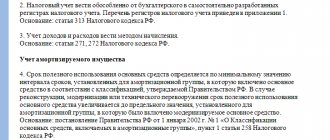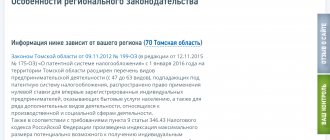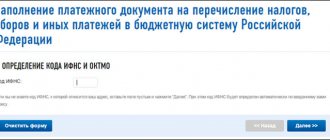Taxation systems for individual entrepreneurs are methods for calculating taxes established by law that individual entrepreneurs can use. What tax reporting is established for individual entrepreneurs in 2020 for different taxation systems - we will tell you in our material.
Individual entrepreneur is an individual carrying out entrepreneurial activities without forming a legal entity. Regardless of the form, any person conducting business activities is obliged to make mandatory payments to the budget. Let's figure out how and what types of taxation for individual entrepreneurs are preferable to choose in 2020.
Tax forms for entrepreneurs
What deductions does an individual entrepreneur make? It depends on the chosen taxation system for individual entrepreneurs 2020:
- general (OSN);
- simplified (USN);
- imputed (UTII);
- patent (PSN);
- systems for agricultural producers (ESHN).
We will tell you how how much taxes an individual entrepreneur pays in 2020 depends on the chosen system. The entrepreneur decides what to choose at the time of registration, and changing the system is allowed from the beginning of the new annual reporting period.
Additional taxes and payments for individual entrepreneurs
Certain types of activities require the payment of additional taxes. These include:
- Tax on the production and sale of excisable goods.
- Mineral extraction tax (MET).
- Water tax for the use of water bodies.
Individual entrepreneurs with special permits and licenses, in addition to additional taxes, must also carry out:
- Regular payments for the use of subsoil.
- Fees for the use of wildlife objects.
- Fees for the use of aquatic biological resources.
Note: Additional taxes, fees and charges must be paid regardless of the tax system in which the individual entrepreneur is located.
Conventional system
The usual system is used by default, if a decision to switch to another is not declared, it determines what taxes an individual entrepreneur must pay:
- personal income tax;
- VAT;
- Transport, land and property taxes are paid according to the rules established for individuals.
At the end of the tax period, the entrepreneur submits a 3-NDFL declaration to the Federal Tax Service. This must be done before April 30 of the year following the reporting year. The 2020 tax return for individual entrepreneurs for VAT is submitted according to the general rules once a quarter.
The most important thing about the simplified tax system 2020
You can choose a taxable object only once a year, so you need to understand in advance what business expenses you may have.
If you started working on the simplified tax system Income, where expenses are not taken into account, and then your costs increased sharply, then you will be able to switch to the simplified tax system Income minus expenses only from the new year. The standard tax rates indicated above can be reduced by regional laws to 1% for the simplified tax system for Income and up to 5% for the simplified tax system for Income minus expenses. For example, in one of the regions there is a standard rate of 6% for the simplified tax system Income and only 5% for the simplified tax system Income minus expenses, but only for construction. As you can see, the second option is more profitable, even if the share of costs is small.
By establishing such preferential rates for certain types of activities, the authorities seek to develop some direction in their region, most often this is production or construction. Therefore, before choosing a simplified taxation object, study the regional law; it is possible that a preferential rate applies to your type of activity. You can find out these features at the Federal Tax Service or the economic department of the local administration.
Free tax consultation
The main limitation on the ability to apply the simplified system is related to the amount of income received during the year. Initially, this amount was 60 million rubles, but from 2020 to 2020 another limit is in force - 150 million rubles.
Another important limitation is set for the number of employees - no more than 100 people. In principle, most individual entrepreneurs meet these conditions and therefore have the right to work under a simplified regime.
Simplified taxation system for individual entrepreneurs in 2020
Having chosen the simplified tax system, an individual entrepreneur does not pay VAT and personal income tax and does not provide reporting on them. As mentioned above, the simplified individual entrepreneur tax 2020, how much to pay, depends on the chosen tax base:
- income;
- income reduced by expenses.
Since the simplified tax system replaces other tax payments, it is necessary to submit a declaration under the simplified tax system once a year and reflect all mandatory payments in it. If the taxpayer has chosen the “income minus expenses” principle, then the simplified taxation system for individual entrepreneurs is set to a maximum of 15%. It is allowed to lower it by the law of the subject of the Russian Federation. Under the simplified tax system “income”, the individual entrepreneur rate is set at 6%. An entrepreneur's mandatory payments to the simplified tax system include property tax payments and insurance premiums for himself and his employees.
During the year, it is necessary to make advance payments, which are calculated based on the results of the 1st quarter, half a year and 9 months. Advances paid are taken into account when calculating the tax amount payable for the year. An entrepreneur can choose a simplified form during registration or switch to this system from January 1 by submitting a corresponding application to the Federal Tax Service.
What taxes does an individual entrepreneur pay in 2020 on the Unified Agricultural Tax?
Agricultural tax is calculated on revenue reduced by expenses. Entrepreneurs get the opportunity not to charge or pay personal income tax on their business income. The special regime provides for exemption from taxation of property assets that are used in agricultural activities (production or processing of agricultural materials, provision of services to agricultural producers). The Unified Agricultural Tax declaration is submitted annually (before April 1 of the following year).
Since 2020, the application of the Unified Agricultural Tax provides for the occurrence of obligations for the entrepreneur to calculate and pay VAT.
If a businessman owns a vehicle or a plot of land, he must pay transport and land taxes for them. The amount of obligations is calculated by the Federal Tax Service; individuals do not need to report on these types of taxes.
UTII for an entrepreneur
This special regime applies only to certain types of activities listed in paragraph 2 of Art. 346.26 Tax Code of the Russian Federation. The decision to apply or refuse UTII is made by regional authorities. Some regions (for example, Moscow) have already abandoned it. The special regime was planned to be abolished throughout the Russian Federation several years ago. But for now the authorities have extended its validity until 2020 inclusive. UTII, like the simplified tax system, eliminates the need to calculate and pay personal income tax and VAT.
The object of taxation is imputed income, determined by calculation. Its size determines what taxes an individual entrepreneur should pay in 2020, and the amount does not depend on real income. The rate is 15% (Article 346.31 of the Tax Code of the Russian Federation). Local laws regulate the rate in the range from 7.5 to 15%.
For UTII it is necessary to submit a quarterly tax return no later than the 20th day of the month following the reporting quarter.
A single tax on imputed income
The benefit of UTII is that the tax base is not revenue, but imputed, that is, theoretical income, and very low. True, there are many restrictions on its use:
- UTII is available for certain types of activities, which are listed in Article 346.26 of the Tax Code of the Russian Federation.
- The regime must be introduced in a specific territory by municipal authorities, and they can limit the list of activities from the Tax Code.
- An individual entrepreneur must have no more than 100 employees.
- From 2020, UTII cannot be used by those who sell goods subject to labeling: clothing and other fur items, medicines, and shoes (Law No. 325-FZ dated September 29, 2019).
But the main problem is that from the beginning of 2021, UTII will be abolished. Some regions (for example, the Perm Territory) began to abandon it already in 2020. However, this regime is still in effect, and entrepreneurs have a chance to take advantage of all its benefits.
Individual entrepreneurs do not pay VAT and their own personal income tax on imputation. Instead, once a quarter he pays a single tax at a rate of 15%. The base depends on a physical indicator, for example, store area, number of employees, units of transport. The indicator is multiplied by the basic profitability, which is prescribed in the Tax Code (Article 346.29), and is also adjusted by the coefficients established by the Ministry of Economic Development and local authorities.
Who benefits from imputation
UTII, as a rule, is beneficial to all entrepreneurs with a large amount of revenue, whose business fits the criteria. It is successfully used by shops, pharmacies, and catering. The mode will not be suitable if the activity allows periods of downtime. After all, the calculated imputed tax will have to be paid in any case. You need to report on imputation often - once every 3 months. But real tax savings completely compensate for this inconvenience.
Get a free tax consultation ►
Patent taxation in 2020
The patent taxation system (PTS) is intended as a replacement for UTII, but is currently being used in parallel with it. If an individual entrepreneur operates on a patent, taxes and mandatory payments in 2020 are similar to UTII. The differences relate to the types of activities to which its application and conditions apply. A patent is acquired for a certain type of activity, which are specified in paragraph 2 of Art. 346.43 Tax Code of the Russian Federation. It is issued for a period of one to 12 months. When carrying out various types of activities, it is allowed to acquire a patent for each of them or combine PSN with other taxation systems.
The rate is set at 6% of the entrepreneur’s potential annual income. A tax return in respect of income from activities on the PSN is not provided. This is the main advantage of this tax system.
How to determine which is more profitable?
Having figured out how to choose a taxation system for individual entrepreneurs in 2019, an entrepreneur must understand that this regime will indeed be optimal for him.
For example, let’s look at which taxation system is better for individual entrepreneurs with retail trade:
- UTII. This regime imposes restrictions on the type of activity, but for small retail trade it is an ideal option. But since there are limitations in the area of the store, one point of sale is open or a network, how many vehicles are available, then trade should be on a small scale.
- Unified Agricultural Sciences. Since the share of revenue from agricultural production is at least 70%, 30% remains for trade.
- USNO. Among the “simplified” conditions there are restrictions on revenue, some organizational issues, the cost of fixed assets, the number of employees and types of activity (excise production, pawnshops, insurance organizations, etc.). This is calculated in advance. However, “simplified” income minus expenses, due to the possibility of deducting costs from the tax base, is the most profitable regime for retail trade.
- PSN. If an entrepreneur falls under the type of activity provided for by law for a patent, then the regime is very beneficial. To do this, you need to take into account the maximum possible size of the premises, profit and number of employees.
- BASIC. Retail trade on a common system is not profitable. Among the trading enterprises, only large retail chains or wholesale trade are forced to be located there. In addition, the burden of record keeping is very high. The only advantage is that you do not need to pay income tax if you receive a loss.
In a similar way, you can analyze not only what type of taxation to choose for individual entrepreneurs in retail trade, but also any other type of activity.
The official portal of the Federal Tax Service will help you calculate whether it will be profitable to work in any of the modes. The service contains updated data on rates, regions and other conditions.
Regimes such as PSN and UTII provide for a fixed fee (the differences are only in the place of work of the individual entrepreneur); for other modes, benefits are calculated according to estimated figures.
Insurance premiums: individual entrepreneur taxes in 2020 without employees
Regardless of the taxation system applied, an individual entrepreneur pays insurance premiums for pension and health insurance for himself. To find out what taxes for individual entrepreneurs without employees are set for social insurance in 2020, you need to refer to Article 430 of the Tax Code of the Russian Federation.
In 2020, a fixed contribution of 6,884 rubles is paid for compulsory medical insurance.
The Pension Fund tax for individual entrepreneurs in 2020 depends on the amount of annual income. If it does not exceed 300,000 rubles, then you only need to pay a fixed fee of 29,354 rubles. With income above 300,000 rubles. an additional contribution of 1% of the excess amount is paid.
Taxes for individual entrepreneurs on the simplified tax system with employees
The content of the article
The procedure for calculating tax contributions for an individual entrepreneur working under a simplified system will depend on what object of taxation he has chosen - income or profit. In the first case, the tax rate is 6%, in the second – 15%. But at the same time, the composition of payments and the timing of their payment will be the same. You can see them in the table below.
| Contribution type | Payment term |
| Advance according to the simplified tax system | Quarterly, before the 25th day of the month following the reporting month |
| Final payment for the year (total tax amount minus advances) | Until April 30, 2020 |
| Personal income tax on employee income | The day after payment of salary |
| Insurance payments for employees | Once a month, before the 15th day of the month following the reporting month |
| Fixed payments for yourself | Until December 31, 2019 |
| Additional contribution (paid if revenue for the previous year exceeded 300,000 rubles) | Until July 1, 2020 |
Important ! Advance payments are calculated on an accrual basis. To calculate each contribution, the tax base (income or profit) is taken for the entire current year, and not just for the reporting period.
If during the reporting period an entrepreneur earned zero income—there is no profit or income—he will not have to pay taxes. But if the result of the activity was a loss - expenses exceeded income - you will still have to make a minimum contribution to the Federal Tax Service. The amount of this contribution will depend on the tax rate in force for the businessman:
- 6% of all income received – for the simplified tax system 6%;
- 1% of all income received – for the simplified tax system 15%.
At the same time, persons who have chosen profit as an object of taxation have the right to include the amount of loss and the minimum tax in the expense item next year. Those who work under the simplified tax system of 6% cannot do this.
But businessmen working under simplified conditions in 2020 are exempt from VAT payments. The only exceptions are individual entrepreneurs engaged in importing goods. Also, entrepreneurs using the simplified tax system (regardless of the rate) are exempt from property tax (transport, real estate, etc.). They will not have to pay contributions for assets that they own, but are used in business.
Important ! To calculate advance payments and the total tax amount for the year, an entrepreneur working under the simplified tax system can use one of the online calculators.
Individual entrepreneur with employees: taxes 2020
If an entrepreneur has employees, then, in addition to payments in accordance with the chosen system, he is obliged to transfer personal income tax and insurance contributions to the budget from the salaries paid to employees. In the table, let’s imagine how much taxes an individual entrepreneur pays in 2020 on employee income:
| Tax payment | Rate (basic) |
| Personal income tax | 13 % |
| Insurance premiums: | |
| compulsory pension insurance | 22% until the employee’s annual income reaches RUB 1,150,000. and 10% of the excess amount |
| compulsory health insurance | 5,1 % |
| disability insurance | 2.9% until the employee’s annual income reaches RUB 865,000. |
| Contributions for injuries | 0.2–8.5%, depending on the type of activity |
In connection with attracting employees and paying them wages, individual entrepreneurs have the obligation to provide additional reporting:
- in the Federal Tax Service: RSV, 6-NDFL and 2-NDFL;
- in FSS: 4-FSS;
- in PF: SZV-STAZH and SZV-M.
Insurance payments
When talking about what taxes an individual entrepreneur pays under the simplified tax system with employees, one must not lose sight of insurance payments. The entrepreneur must pay them to the Federal Tax Service on a monthly basis within the period established by law. The list of such payments includes:
- pension insurance payments - 22% of the income received by the employee (or 10% if accruals for the employee exceed 1,150 thousand rubles);
- medical insurance - 5.1% of the salary received by the employee;
- payments for social insurance - 2.9% (not paid if accruals for an employee exceed 865 thousand rubles).
Expert opinion
Albina Ibragimova
Economist by profession, former specialist in the legal services department.
Insurance for accidents at work is paid to the Social Insurance Fund, not the Federal Tax Service. The amount of payments here will depend on the category of professional risk of the employee. You can check the final percentage at your regional FSS office.
The entrepreneur must also pay certain contributions for himself. Previously, their size was calculated depending on the minimum wage in force in the region of work of the businessman. But starting from 2020, these payments have fixed values:
- 32,448 rubles (in 2020 - 29,354 rubles) - payments for compulsory pension insurance;
- 8,426 rubles (in 2020 - 6,884 rubles) - contributions to compulsory medical insurance.
The total amount of insurance premiums in 2020 will be 40,874 rubles .
Important ! The entrepreneur makes payments for himself once a year, within the time limits established by law, to the relevant authorities.
Please note that the indicated amounts will be relevant only for businessmen registered with the tax service throughout 2020. If the individual entrepreneur was registered in the current year, or, on the contrary, ceased operations after the beginning of 2020, the amount of contributions for it will be calculated using the following formula:
((OPS+OMS)/12)*M
where – OPS – statutory payment to the pension fund;
Compulsory medical insurance – a payment established by law to the health insurance fund;
M – the number of months in which the entrepreneur was registered with the Unified State Register of Individual Entrepreneurs.
A businessman who uses the simplified tax system as a working tax system can receive a deferment on insurance premiums for himself. It is provided in the following cases:
- service in the ranks of the Armed Forces;
- being on parental leave (up to 1.5 years);
- being on leave to care for a disabled person of group 1, an elderly family member (over 80 years old), or a disabled child;
- departure with a spouse serving on a contract basis to a region where there is no opportunity to conduct business;
- departure abroad with a spouse sent to a consulate, diplomatic mission or permanent residence.
Naturally, in all of the above cases, the entrepreneur must document the situation that caused the delay in payments. All necessary papers will need to be submitted to the local FSS office before the end of the payment period.
Important ! When making compulsory social insurance contributions, entrepreneurs working under simplified conditions do not pay for themselves this year. Changes in Russian legislation will show what the situation with these payments will be in the future.
Tax benefits for individual entrepreneurs in 2020
For entrepreneurs who registered for the first time and started operating, the regions are introducing tax holidays for individual entrepreneurs in 2020 in accordance with clause 4 of Art. 346.20 and paragraph 3 of Art. 346.50 Tax Code of the Russian Federation. They consist in establishing a zero rate when carrying out activities in the following areas:
- production;
- social;
- scientific;
- provision of household services to the population.
An entrepreneur can use tax exemption if the subject of the Federation has adopted such a regional law and it is in force to this day. If tax holidays were used in 2017-2018, then there was an increase in taxes for that category. In some regions, laws establishing tax holidays expired on January 1, 2019 (for example, in the Republic of North Ossetia-Alania, Stavropol Territory and Kaliningrad Region).
Before registering a business you need:
The article briefly describes all the differences between individual entrepreneurs and LLCs in the form of a comparative table.
Which is better: individual entrepreneur or LLC? In general, an individual entrepreneur is a business built on one person. An LLC is an organization in which roles and profits can be distributed and more subtle legal relationships can be established.
Classification of activities. Some activities can only be carried out after obtaining a license
Do you need a license? Types of activities - licensed, unavailable, requiring permission, ordinary... Licensed types of activities include: tour operator, pharmaceutical, private investigation, transportation by rail, sea, air transport of goods and passengers...
Subsidy 58800 tr. for providing a business plan. Employment center consultations, reimbursement of expenses for creating an individual entrepreneur, LLC
58800 rub. from the Employment Center and other assistance To receive any assistance, you need to be registered with the employment center... Reimbursement of expenses for registering a company... 58,800 rubles for business development... Free consultations...
Debt write-off
At the end of 2020, on behalf of the President of the Russian Federation, Law No. 436-FZ was adopted, recognizing arrears on a number of obligatory payments to the budget as hopeless for collection. The “tax amnesty” also affected individual entrepreneurs. The write-off of tax debts for individual entrepreneurs was applied from 2020 as well.
To be written off in 2020:
- insurance premiums for periods before 01/01/2017;
- arrears on tax payments on property, transport and land of individuals accrued before 01/01/2015.
The write-off was carried out by the tax authorities without the participation of taxpayers. There was no need to report to the Federal Tax Service. The entrepreneur can only check the fact of the write-off. In 2020, a similar campaign to write off tax debts is not provided.
A separate offer for agricultural producers - Unified Agricultural Tax
As the name implies (Unified Agricultural Tax, Chapter 26.1 of the Tax Code), entrepreneurs engaged in the agricultural industry have the right to choose this special regime.
Such a system includes the following types of activities:
- crop production;
- livestock farming (including breeding and growing fish);
- services provided to agricultural producers in the field of livestock and crop production (from 01/01/2017);
- production of other products in the agriculture and forestry industries.
Processing of agricultural raw materials without their production (cultivation) does not fall under the Unified Agricultural Tax.
The special regime is exempt from taxes:
- income tax;
- property tax;
- personal income tax;
- VAT.
The transition from another regime to the Unified Agricultural Tax is carried out only from the beginning of the new year. Newly created individual entrepreneurs must submit a notification to the Federal Tax Service within 30 days from the date of registration that they will work in this mode.
Another prerequisite for applying this taxation system is income from agricultural activities of at least 70% of the total amount.
The object of taxation by the unified agricultural tax is income reduced by expenses. Rate – 6%.
Calculation formula: Tax amount = (income – expense) x 6%.
Income and expenses are taken into account on an accrual basis from January 1 of each year. Expenses include losses from previous years.
Single tax reporting is provided once every six months. The advance payment for the six months is made to the budget within 25 days from its end (until July 25). The final payment for the year is due by March 31 of the following year.
Business registration:
How to register an individual entrepreneur yourself? Individual entrepreneur registration procedure, free step by step 2019-2020. Sample documents for individual entrepreneur registration. Selection of OKVED codes for individual entrepreneurs 2019-2020. Sample application for individual entrepreneur registration
Registering an individual entrepreneur yourself Step 1 Select an activity code... Step 2 Application for registration... Step 3 Pay the state registration fee... 7 steps in total.
How to register an LLC yourself? LLC registration procedure, free step by step 2019-2020. Sample documents for LLC registration. Selection of OKVED codes for LLC 2019-2020. Sample application for LLC registration
Registration of an LLC (organization) Step 1 Selecting an activity code... Step 2 A legal address is required... Step 3 Selecting an LLC name... Step 4 Application for registration... A total of 13 steps.
Registration of individual entrepreneurs and LLCs with pension, statistics, Compulsory Medical Insurance, Social Insurance Fund. As well as opening a bank account, making a seal, registering a cash register
Registration with pension, statistics, MHIF. And also: Stamp, cash register, bank account. You must register LLC and individual entrepreneur in three bodies: Pension Fund, Compulsory Medical Insurance Fund, statistics... A cash register, seal and bank account in the bank are not mandatory for individual entrepreneurs, but are really necessary for carrying out activities ...
Useful...
Sample documents for working with customers and partners. Contract, certificate of completion of work, invoice for the contract and much more
Agreement. Acts. Invoices and other documents for working with the customer. The sample agreement is drawn up in 2 copies: one for the customer, the other for the Contractor... An invoice is not required. Invoiced for payment under the contract, so you are reminded once again about payment...
Comparative table of paid and free office programs - Microsoft Office, OpenOffice, Photoshop, 1C Accounting, Business PAC and others
Paid and free office programs. In business, you can only use licensed paid programs or programs with a free license (freeware). A table is provided with paid programs and free analogue programs...
Samples of documents for working with personnel. Employment contract, statements, job descriptions and much more
Hiring employees: step-by-step instructions An employment contract may have many conditions and obligations, but they should not contradict the labor code... Sample application for voluntary resignation...
Question answer
Show/hide the most frequently asked questions regarding registration of individual entrepreneurs and organizations.
Why is registration needed?
The fine for illegal business activities is from 5 to 20 minimum wages. Registration will open up many opportunities for you. Such as: concluding contracts, renting an office, hiring employees, etc.
Is it possible to register a company and still work officially?
Registration of an individual entrepreneur or registration of an LLC does not in any way affect the right to work for someone. You can register a company (IP, LLC) in parallel with your main job. But, if you are registered with the employment center, then you can be reimbursed for the costs associated with registering an individual entrepreneur (including the production of a seal). Also in 2011, you can get 58.8 thousand rubles for creating an individual entrepreneur or creating an LLC. from the employment center, if you provide a business plan.
What is the difference between registering an enterprise, firm, company, organization and registering an individual entrepreneur or LLC?
Registration of an enterprise, firm, company, organization - synonyms and unofficial names for registration of legal forms of individual entrepreneurs, LLC, CJSC, JSC
Where does registration take place?
State registration of individual entrepreneurs and LLCs is entrusted to the tax service. Registration as an individual entrepreneur and taxes (except for UTII) and pension fees are submitted in the region to the address indicated in the passport. An entrepreneur can conduct business anywhere in Russia. The place of registration of all individual entrepreneurs and LLCs in Moscow is in tax office No. 46 (MIFTS No. 46 address: Moscow, Pokhodny proezd, possession 3, building 1). In other cities - in tax districts at the place of residence. Registration of a legal entity is carried out at the legal address of the main office.
Do I need to seek help from law firms for paid registration?
Self-registration of an individual entrepreneur or LLC is free if you contact the Employment Center; It will take you about a week of time, but you will not only save money, but will also better navigate the authorities and laws. There are many offers on the market for paid assistance with registration in Moscow, St. Petersburg and other cities - the cost ranges from 1,500 to 20,000 rubles. Depends on the difficulty. You can ask such companies to list the items and prices of what they offer. Perhaps you will register a company yourself, and companies will help you in some way.
What is needed to open an individual entrepreneur?
Two weeks time. About 2000-3000 rubles expenses. Read more... Creating an individual entrepreneur step by step
How long does it take to register an individual entrepreneur and LLC?
The application for registration is considered by the tax authorities within no more than 5 working days. The actual period may be longer.
Can another person register a company for me?
You can also instruct someone to carry/pick up documents for registration using a notarized power of attorney - Power of Attorney for the provision of interests of individual entrepreneurs and LLCs in Tax.doc. You just have to take the documents for registering an LLC in Moscow in person (they can pick it up by proxy)
What are the pension contributions of individual entrepreneurs?
In 2020
Fixed payment to the Pension Fund of Individual Entrepreneurs (paid once a year, until December 31) to the Pension Fund of the Russian Federation -
29,354 rubles.
the entire amount is paid for the insurance part, regardless of the age of the individual entrepreneur, FFOMS -
6,884 rubles.
Total amount:
36,238 rub.
. With an income of 300,000 rubles (cumulative total for the year), you will need to pay additionally plus 1% (pay before July 1) of the difference (total income - 300,000 rubles), but no more than based on 8 minimum wages (for the Pension Fund of the Russian Federation) .
In 2020
Fixed payment to the Pension Fund of Individual Entrepreneurs (paid once a year, until December 31) to the Pension Fund of the Russian Federation -
26,545 rubles.
the entire amount is paid for the insurance part, regardless of the age of the individual entrepreneur, FFOMS -
5,840 rubles.
Total amount:
32,385 rub.
. With an income of 300,000 rubles (cumulative total for the year), you will need to pay additionally plus 1% (pay before July 1) of the difference (total income - 300,000 rubles), but no more than based on 8 minimum wages (for the Pension Fund of the Russian Federation) .
Is it possible to deposit cash into an individual entrepreneur's current account?
Yes, an entrepreneur has the right to deposit his own funds into a current account. There are no restrictions on amounts established by law. In the announcement for a cash contribution, you can indicate “your own funds” in the “Source of funds” column.
Which tax system should you choose?
Simultaneously with opening a company, it is necessary to decide on taxation systems; they are tied to the main activity code indicated in the application for registration of an individual entrepreneur or LLC. The code may fall under UTII (imputation). If the code does not fall under UTII, then the choice is the simplified tax system (simplified) or OSNO. Also, a company can combine two systems: UTII and simplified tax system or UTII and OSNO. Read the section: Which tax to choose?
How to suspend the activities of an individual entrepreneur?
You can suspend your activity only if you are on UTII by submitting an application to the tax office using the UTII-4 form. The simplified tax system and OSNO either pay less tax or you submit zero reports. You have to pay into your pension anyway.
See also: clarifications of the Letter from the Ministry of Finance
See also: Answers from the Federal Tax Service
About business
How to open a profitable, profitable business?
You shouldn't start a business from scratch. It is necessary to have a financial base, and it is also very desirable to work in the field in which you want to open a business. You can start by creating your own business as additional income.
Small business ideas must be adapted to reality. First of all, for yourself, for your character. The most important thing is that you enjoy supporting and developing your business.
The more you think about how best to provide services to clients/partners, the more they will be attracted to you and your profit will grow.
ADVIСE
- Please read the site materials carefully. You, as a future entrepreneur, must navigate the documents and know what you are signing
- Make a copy of all documents
- Please fill out the registration form carefully; if you make a mistake, the state fee will not be returned to you.
- Read all the steps in the sections registering an individual entrepreneur or registering an LLC, perhaps you will do something in parallel
- Take your passport with you. In government organizations you are required to present it
- Save all receipts and documents of individual entrepreneurs, LLCs and seals
- Never leave original documents or stamps with anyone. They have no right to take them away
- Pay special attention to working with the tax office; all messages and notifications to the tax office must be documented. Send mail to the tax office in a valuable letter with a list of attachments
- Do not transfer any non-contractual or personal funds to your current account. This account is controlled by the tax office; they may then ask you where the funds come from and naturally demand tax.
- Use tax calculators to help you identify errors. Individual entrepreneurs can use online accounting for free for a year and send all reports via the Internet.
TOP 7 myths of business organization.
- Reporting may not be submitted.
Reporting must always be submitted in full, whether the activity is ongoing or not. It doesn’t matter what benefits (vacations) and rates you apply. It is necessary to submit (even zero) reports. And it’s better to immediately switch to the simplified tax system (USN) upon registration - zero reports there are much simpler. - OKVED is our everything...
Many people mistakenly give excessive importance to OKVED statistics codes. They believe that “the main turnover should be according to the main code” and “you need to report on all codes.” In reality: you can enter 20-40-100 OKVED codes into the constituent documents, and report on one or two types of activities. There is no need to report for extra codes and there are no fines for them. But if there is no code in the constituent documents, then new codes must be added within 3 working days (fine 5,000 rubles). - VAT is required for OSNO, but not possible for USN
. Individual entrepreneurs and organizations on OSNO, whose turnover for three months was less than two million rubles, have the right not to pay VAT, but are required to notify the tax office about this. (Article 145 of the Tax Code of the Russian Federation). On the simplified tax system and UTII it is possible to voluntarily issue invoices with VAT and pay it to the budget. - UTII (imputation) and Patent are available throughout Russia
. UTII and Patent are introduced by local authorities for certain types of activities. For example, in Moscow, UTII has been introduced only for outdoor advertising. - I can only conduct business in my native region
. The Constitution of the Russian Federation enshrines the right to reside, work and conduct business anywhere in Russia. - UTII is better than the simplified tax system or a patent or vice versa
. Since 2013, you can choose between UTII, Patent and simplified tax system. You need to consider what is more profitable and what is available in your region. With UTII and Patent, KKM is not needed. When accepting cash using the simplified tax system, you need a cash register or BSO. - Pension tax
. It is not a tax that is paid to the pension fund, but a fixed pension insurance fee. The difference from a tax is that the tax is transferred to the state free of charge, and the collection is transferred to your retirement account. Unlike tax, the individual entrepreneur’s pension fee is paid regardless of whether the business is active or not.








